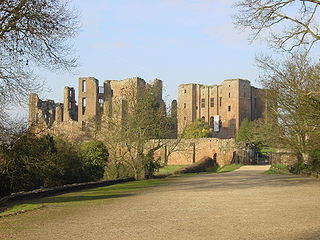
Kenilworth Castle is a castle in the town of Kenilworth in Warwickshire, England which was founded during the Norman conquest of England; with development through to the Tudor period. It has been described by the architectural historian Anthony Emery as "the finest surviving example of a semi-royal palace of the later middle ages, significant for its scale, form and quality of workmanship". Kenilworth played an important historical role: it was the subject of the six-month-long siege of Kenilworth in 1266, thought to be the longest siege in Medieval English history, and formed a base for Lancastrian operations in the Wars of the Roses. Kenilworth was the scene of the removal of Edward II from the English throne, the perceived French insult to Henry V in 1414 of a gift of tennis balls, and the Earl of Leicester's lavish reception of Elizabeth I in 1575. It has been described as "one of two major castles in Britain which may be classified as water-castles or lake-fortresses...".
Alexandria Bay is a village in Jefferson County, New York, United States, within the town of Alexandria. It is located in the Thousand Islands region of northern New York. The population of the village was 1,078 at the 2010 United States Census. It lies near the Thousand Islands Border Crossing of Canada and the United States.

The Thousand Islands constitute a North American archipelago of 1,864 islands that straddles the Canada–US border in the Saint Lawrence River as it emerges from the northeast corner of Lake Ontario. They stretch for about 50 miles (80 km) downstream from Kingston, Ontario. The Canadian islands are in the province of Ontario and the U.S. islands in the state of New York.

Ashby de la Zouch Castle is a ruined fortification in the town of Ashby-de-la-Zouch, Leicestershire, England. The castle was built by William, Lord Hastings, a favourite of Edward IV, after 1473, accompanied by the creation of a 3,000-acre (1,200 ha) park. Constructed on the site of an older manor house, two large towers and various smaller buildings had been constructed by 1483, when Hastings was executed by Richard, Duke of Gloucester. The Hastings family used the castle as their seat for several generations, improving the gardens and hosting royal visitors.

The Province of Ragusa was a province in the autonomous region of Sicily in southern Italy, located in the south-east of the island. Following the abolition of the Sicilian provinces, it was replaced in 2015 by the Free municipal consortium of Ragusa. Its capital is the city of Ragusa, which is the most southerly provincial capital in Italy.

The Thousand Islands International Bridge is an American-maintained international bridge system over the Saint Lawrence River connecting northern New York in the United States with southeastern Ontario in Canada. Constructed in 1937, with additions in 1959, the bridges span the Canada–US border in the middle of the Thousand Islands region. All bridges in the system carry two lanes of traffic, one in each direction, with pedestrian sidewalks.

George Charles Boldt Sr. was a Prussian-born American hotelier. A self-made millionaire, he influenced the development of the urban hotel as a civic social center and luxury destination.

Boldt Castle is a major landmark and tourist attraction in the Thousand Islands region of the U.S. state of New York. Open to guests seasonally between mid-May and mid-October, it is located on Heart Island in the Saint Lawrence River. Heart Island is part of the Town of Alexandria, in Jefferson County. Originally a private mansion built by American millionaire George Boldt, it is now maintained by the Thousand Islands Bridge Authority as a tourist attraction.

Kirby Muxloe Castle, also known historically as Kirby Castle, is a ruined, fortified manor house in Kirby Muxloe, Leicestershire, England. William, Lord Hastings, began work on the castle in 1480, founding it on the site of a pre-existing manor house. William was a favourite of King Edward IV and had prospered considerably during the Wars of the Roses. Work continued quickly until 1483, when William was executed during Richard, Duke of Gloucester's, seizure of the throne. His widow briefly continued the project after his death but efforts then ceased, with the castle remaining largely incomplete. Parts of the castle were inhabited for a period, before falling into ruin during the course of the 17th century. In 1912, the Commissioners of Work took over management of the site, repairing the brickwork and carrying out an archaeological survey. In the 21st century, the castle is controlled by English Heritage and open to visitors.

A dovecote or dovecot, doocot (Scots) or columbarium is a structure intended to house pigeons or doves. Dovecotes may be free-standing structures in a variety of shapes, or built into the end of a house or barn. They generally contain pigeonholes for the birds to nest. Pigeons and doves were an important food source historically in the Middle East and Europe and were kept for their eggs and dung.

Piel Castle, also known as Fouldry Castle or the Pile of Fouldray, is a castle situated on the south-eastern point of Piel Island, off the coast of the Furness Peninsula in north-west England. Built in the early-14th century by John Cockerham, the Abbot of neighbouring Furness Abbey, it was intended to oversee the trade through the local harbour and to protect against Scottish raids. The castle was built using stones from the local beach, and featured a large keep with surrounding inner and outer baileys. It was used as a base by the Yorkist pretender Lambert Simnel in 1487, but by 1534 it had fallen into ruin and passed into the hands of the Crown. Sea erosion began to cause significant damage to the castle in the early 19th century. In the 1870s the castle's owner, the Duke of Buccleuch, carried out extensive restoration work and erected outworks to protect it against further damage from the sea. In 1920 the castle was given to the town of Barrow-in-Furness and is now in the care of English Heritage.

Longue Vue Island is an island located in the Thousand Islands region on the Saint Lawrence River. The island is on the American side of the river, adjacent to the St. Lawrence Seaway channel in Northern New York. It is a part of the Town of Alexandria, in Jefferson County, New York. It is the only artificial island in the entire region.

Weeting Castle is a ruined, medieval manor house near the village of Weeting in Norfolk, England. It was built around 1180 by Hugh de Plais, and comprised a three-storey tower, a substantial hall, and a service block, with a separate kitchen positioned near the house. A moat was later dug around the site in the 13th century. The house was not fortified, although it drew on architectural features typically found in castles of the period, and instead formed a very large, high-status domestic dwelling. It was probably intended to resemble the hall at Castle Acre Castle, owned by Hugh's feudal lord, Hamelin de Warenne.

An unfinished building is a building where construction work was abandoned or on-hold at some stage or only exists as a design. It may also refer to buildings that are currently being built, particularly those that have been delayed or at which construction work progresses extremely slowly.

Goodwin & Company was an American tobacco manufacturer from New York City. Initially E. Goodwin and Brother, the company was founded before the American Civil War. It was known for its cigarette brands "Gypsy Queen" and "Old Judge". In 1890, the company was merged, along with four others, into James Buchanan Duke's American Tobacco Company to create an American monopoly on tobacco product manufacturing and retail.

Rock Island Light is a lighthouse on Rock Island in the Saint Lawrence River in Jefferson County, New York, United States. The island is owned by the New York State Office of Parks, Recreation and Historic Preservation and operated as Rock Island Lighthouse State Park.

George C. Boldt Yacht House is an historic yacht house located on the northeast shore of Wellesley Island near Alexandria Bay in Jefferson County, New York. It was commissioned by George Boldt to house the many watercraft he owned and is adjacent to Boldt Castle.
Kestrel is a steam yacht that was built in 1892. It is located in the George C. Boldt Yacht House on the Saint Lawrence River in Jefferson County, New York.

Marmion Tower, also known historically as Tanfield Castle, is a 15th-century gatehouse near the village of West Tanfield in North Yorkshire, England. It survived the destruction of the surrounding fortified manor and is now managed by English Heritage.

Thousand Island dressing is an American salad dressing and condiment based on mayonnaise that can include olive oil, lemon juice, orange juice, paprika, Worcestershire sauce, mustard, vinegar, cream, chili sauce, tomato purée, and ketchup or Tabasco sauce.


















